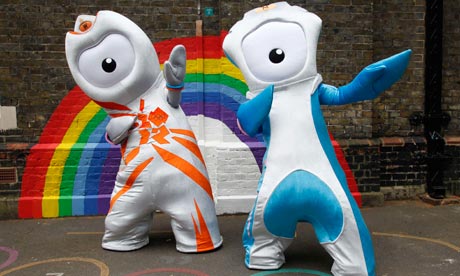
The 2012 Olympic mascot Wenlock (L) and Paralympic mascot Mandeville pose for photographers in the playground at St. Paul's primary school in London Photograph: Suzanne Plunkett/Reuters
In the end they were neither animal, vegetable nor mineral. Nor, as some cynics had predicted, did they resemble white elephants.
Instead, Wenlock and Mandeville, the London 2012 Olympic and Paralympic mascots, elicited mostly baffled reactions as to just what they were at their unveiling today.
With a metallic finish, a single large eye made out of a camera lens, a London taxi light on their heads and the Olympic rings represented as friendship bracelets on their wrists, they resemble characters dreamed up for a Pixar animation.
But London 2012 organisers, for whom the launch of the mascots marks the start of a crucial period in which the games will become public property, pointed to the delighted reaction of a hall full of primary school children at today's launch as evidence that they would connect with their target audience.
"They remind you of aliens, which is really weird and cool," said 10-year-old Ali. "It reminds you of the Olympics, which is worldwide so it's something you'll want to remember forever," added 11-year-old Zanyab as they cavorted with life-size mascots for the cameras.
The pair are based on a short story by children's author Michael Morpurgo that tells how they were fashioned from droplets of the steel used to build the Olympic stadium. They will be crucial in raising funds and spreading messages about the games.
Wenlock, named after the Shropshire town of Much Wenlock that helped inspire Pierre de Coubertin to launch the modern Olympics, and Mandeville, inspired by the Buckinghamshire town where the Paralympics were founded, will become very familiar over the next two years.
The chairman of the London organising committee of the Olympic games (Locog), Lord Coe, said the mascots were aimed squarely at children and designed with the digital age in mind. He said they had the most positive reaction in workshops to road test them.
Among the designs rejected at the start of an open pitch process were anthropomorphic pigeons, an animated tea pot and a Big Ben with arms and legs.
Children will be encouraged to interact with the characters, inviting them via Facebook, Twitter and the web to visit their school and, said Coe, inspiring them to take up different sports.
"The story itself is very rooted in the nations and regions. Young people will be able to decide where they go, what sports they pick up. There is a real interactivity there, it is a language and a flexibility that is driven by young people," he said.
The pair were introduced in an animated film that followed their story from the Bolton steelworks where the frame of the Olympic stadium was made. They will become a range of up to 30 cuddly toys, including versions based on celebrities and sports stars, as well as adorning badges, T-shirts, mugs and more.
Organisers hope Wenlock and Mandeville will rank alongside the more fondly remembered mascots, such as Waldi the dachshund from the 1972 Berlin games and Misha the bear from the 1980 Moscow Olympics rather than the much maligned Izzy of Atlanta 1996.
"The games have got a few stupendous assets the mascot, tickets, the volunteers, the torch relay and you have got to really use those to bring home your key messages," said Locog's chief executive, Paul Deighton.
"If you link them together you begin to have a really powerful story that people will respond to."
The unveiling of the bold London Olympics logo in 2007 was controversial, with many criticising its graffiti-like design. Organisers, who hired Wolff Olins at a cost of 400,000 to design it, stood firm, arguing that it was supremely adaptable and perfect for the digital age. But they were forced to withdraw a launch film after it emerged that it had the potential to trigger epileptic seizures.
The mascots, conceived by London design agency Iris and costing, said Deighton, just "a few thousand pounds", are an important staging post from a financial and marketing point of view. They will pour up to 15m into the coffers of the organising committee via dozens of licensing deals, part of an overall licensing target of 70m to 80m towards Locog's 2bn privately raised budget.
In 1984, the LA games ushered in the money-spinning Olympic era. The event was the first to use its Disney-designed mascot to raise funds, since when they have become a cash cow for organisers.
But the story behind the mascots is also designed to help make the Olympics relevant to the whole nation. That will be crucial if organisers are to maintain support for a project that is also costing the public 9.3bn, particularly as cuts in public services begin to bite.
After a spell of behind-the-scenes work devoted to raising 700m in sponsorship revenues, Locog is entering a more public phase when everything it does, from the unveiling of the mascot to its ticket pricing policy, will come under scrutiny.